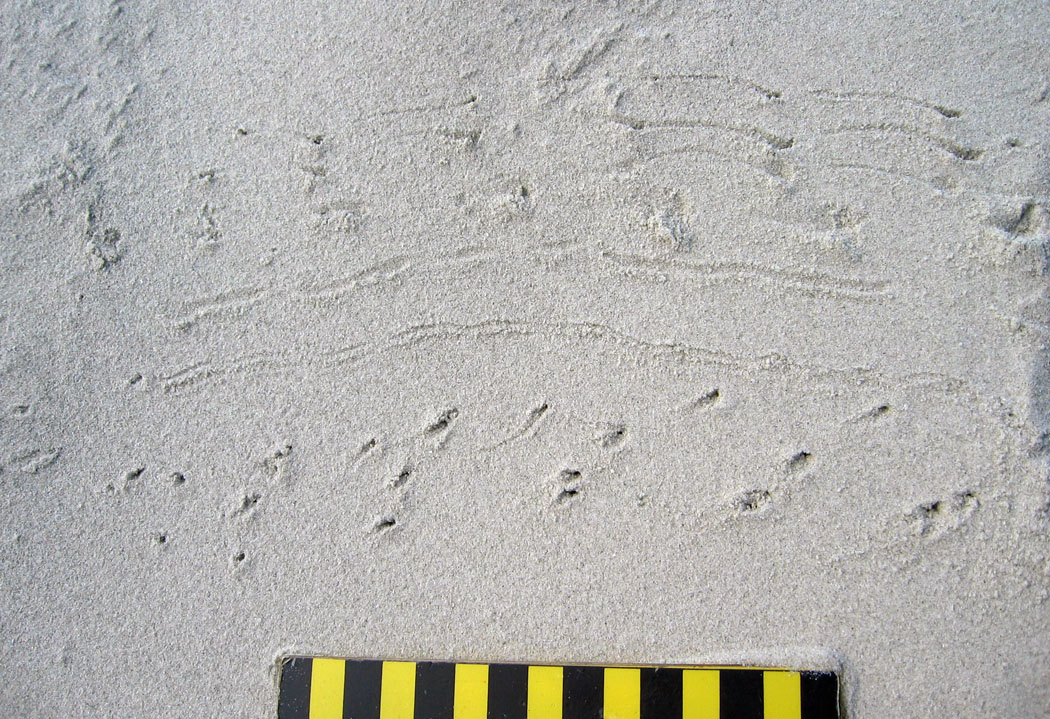For today’s photo and discussion, let’s take a look at one of my favorite tracemakers of the Georgia barrier islands – the ghost crab (Ocypode quadrata) – and its most commonly encountered traces on the dunes and beaches of those islands, tracks. Because I like these animals and their traces so much, I will restrain myself from prattling on too long about these semi-terrestrial crustaceans and their traces. Instead I’ll focus on this one example of ghost crab tracks and what they tell us about its anatomy and behavior.
 Tracks made by a ghost crab (Ocypode quadrata) while walking along the side of a coastal dune on Sapelo Island. Ghost crabs use eight of their ten appendages for walking (legs, or pereopods), and the other two (claws, or chelipeds) are used for grasping and pinching. Because most of their walking is done sideways, one set of four legs often precede the other set. Look for the repeating pattern of four clustered imprints toward the lower left of the photo, and notice how these are clearly defined, whereas the upper sets are elongated, suggesting that this was the trailing set of legs. But wait: what’s with the two drag marks in the center of the trackway? Please read on. (Photograph by Anthony Martin; scale in centimeters.)
Tracks made by a ghost crab (Ocypode quadrata) while walking along the side of a coastal dune on Sapelo Island. Ghost crabs use eight of their ten appendages for walking (legs, or pereopods), and the other two (claws, or chelipeds) are used for grasping and pinching. Because most of their walking is done sideways, one set of four legs often precede the other set. Look for the repeating pattern of four clustered imprints toward the lower left of the photo, and notice how these are clearly defined, whereas the upper sets are elongated, suggesting that this was the trailing set of legs. But wait: what’s with the two drag marks in the center of the trackway? Please read on. (Photograph by Anthony Martin; scale in centimeters.)
What caught my eye about this trackway is that it shows it was made by a real decapod (= “ten legged” crustacean), and not, say, some uncomfortably large spider that just happened to go for a walk along a Georgia-coast beach. The two central drag marks are from its claws, which the crab held low enough while it walked so that these left impressions on the sand. Like many decapods, one claw on a ghost crab is larger than the other. Appropriately, this is called its superior cheliped and the smaller one is its inferior cheliped.
Normally when ghost crabs walk, their claws point down, so if they hold them low enough, the claw tips register on the sand and leave such drag marks. In this photo, the offset you see between those claw-tip impressions is because of their size differences, where the big claw is in front of the small one. For this crab and its trackway pattern, I think it was moving from right to left, so the upper drag mark would be from its big claw, and the lower one from its small claw. Unless if I’m wrong on that, in which case, just reverse what I said.
Have ghost crab tracks been interpreted from the fossil record? No, not yet, although trace fossils of their burrows are very common. So if any potential candidates of such trackways are discovered, one of the first questions I would ask is whether they also preserve claw impressions, showing these really were from a ten-appendaged critter, and not some arachnid imposter.
Further Reading
Ocypode quadrata: Atlantic ghost crab. Animal Diversity Web (University of Michigan).
Atlantic Ghost Crab: Ocypode quadrata. David Knott, Department of Natural Resources, South Carolina. (PDF)
Links to Previous Posts in This Theme
On the 12th Day of Ichnology, My Island Gave to Me: 12 Snails Grazing
On the 11th Day of Ichnology, My Island Gave to Me: 11 Plovers Probing
On the 10th Day of Ichnology, My Island Gave to Me: 10 Beetles Boring
On the 9th Day of Ichnology, My Island Gave to Me: 9 Molluscans Hiding
